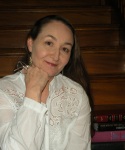On the airplane coming home from a humanities conference recently, the woman sitting next to me was reading Written in My Own Heart’s Blood (2016) by Diana Gabaldon. Intermittently, she put down the novel and picked up the knitting in her lap. Her progress told me that she was making a baby sweater.
Gray hair, traveling alone, reading an 1152-page historical novel, and knitting represents one end of the spectrum of readers who enjoy historical romance. The other end of the spectrum stated in a 2013 SquareSpace study of romance fiction statistics maintains: minimum age 30, college-educated, minimum income $55,000/year (Static).
I asked my seatmate if she’d read Gabaldon’s other books in the series.
“Every one of them,” she replied emphatically.
I remarked on the average page count of a Gabaldon work to which she answered, “I’ve read a couple of them twice.”
Before deplaning, I wanted to know why.
“Jamie.”
Not the historical accuracy, not the cable television series, and not being part of a community, but the draw of the character. Just when I thought surveys and social media were gospel when it comes to understanding readership, I bump into Nana.
I stopped to think, not only about my potential readership but the impression of my beta hero, whose quiet nature may make him appear too passive to survive frontier life, let alone the prejudice and ostracism guaranteed for him following ten years as a captive of the Delaware Indian tribe during the American Revolution.
Would this woman on the plane, obviously intellectually, physically, emotionally, and financially capable of appreciating historical romance fiction, be attracted to my hero?
More important (well, maybe) to this conversation is how high or not is her brow?
The literary term ‘middlebrow’ rubs me the wrong way. Reminds me of a relative’s unibrow curse. I’m familiar with the condescending attitude the terminology implies as also noted by author Nicola Humble in “The reader of popular fiction”:
“The concept of the middlebrow is a notoriously vexed one. ‘Middlebrow’ has always been a dirty word. Since it’s coinage in the late 1920s [there’s some discrepancy about this date] it has been applied, almost always disparagingly, to the sort of cultural products thought to be too easy, insular and smug” (Cambridge 92).
Briefly, ‘highbrow’ and ‘lowbrow’ are outgrowths of the questionable science phrenology presented in 1796 by German physician Franz Joseph Gall. He claimed that bumps on the head were directly related to “organs” in the brain that he associated with a range of functions such as someone’s propensity to love or tell secrets.
This pseudoscience was short-lived by the 1840’s across Europe and America. Those that will bastardize picked up on phrenology and claimed that having a high forehead indicated intelligence and a short forehead pointed to less mental capacities. I was unable to find anything pointing directly to Gall proposing these stereotypes. I’m not defending the concept, but the father of phrenology didn’t intentionally mean for it to be used as a class, racial, or intellectual divisor (Manual of Phrenology 83). But it has been and obviously continues.
Do I think the baby boomer grandmother would appreciate my historical romance? I do. There is a 2013 survey by author M.K. Tod that supports this here. P.S. Note in the report where baby boomers say they primarily learn about new books.
All good things,
j

Humble, Nicola. “The Reader of Popular Fiction.” The Cambridge Companion to Popular Fiction. Ed. David Glover and Scott McCracken. New York: Cambridge University Press, 2012. 86-102.
Manual of phrenology : being an analytical summary of the system of Doctor Gall, on the faculties of man and the functions of the brain : translated from the 4th French ed. Philadelphia : Carey, Lea & Blanchard, 1835.
“Romance Fiction Statistics.” Static1, SquareSpace, 24 Jan. 2019, http://writerwellness.files.wordpress.com/2020/03/4059e-romancestats.pdf
“10 Facts on Boomer Readers.” Inside Historical Fiction, 24 Jan. 2019, https://awriterofhistory.com/2015/11/09/10-facts-on-boomer-readers/
